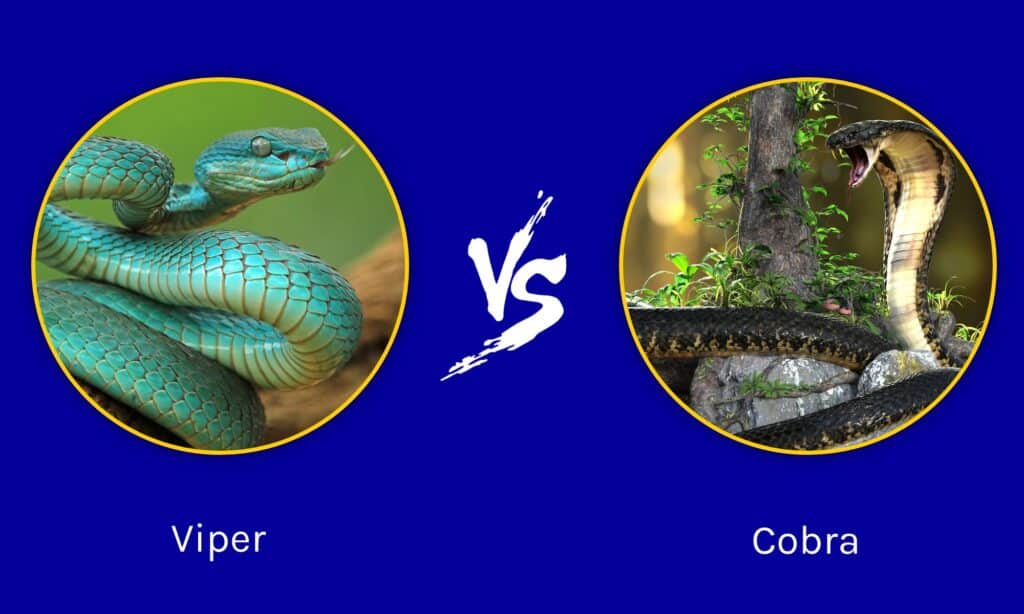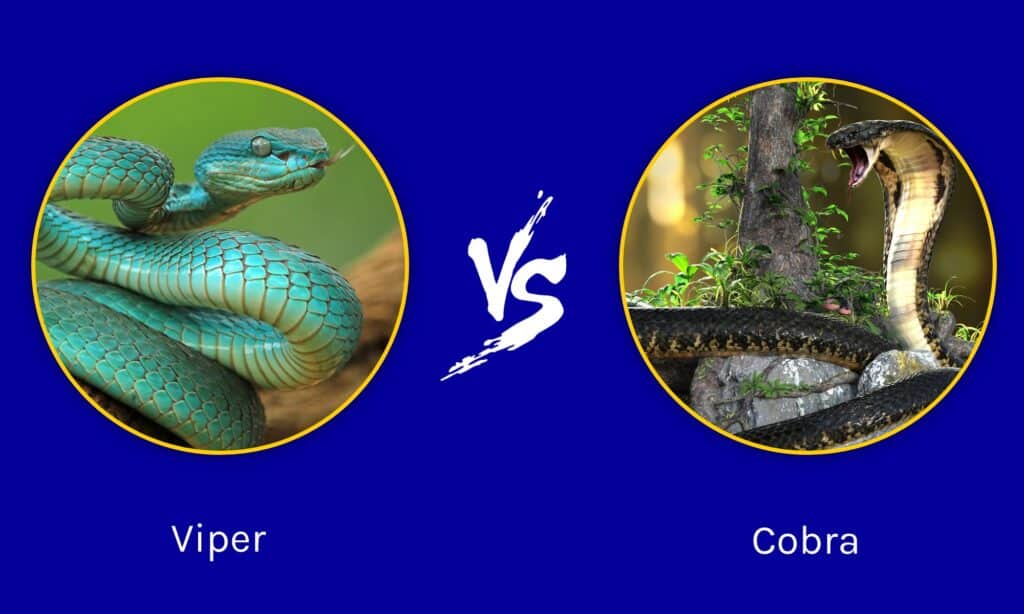Cobras and vipers are two of the most iconic and feared snakes in the world. With their venomous bites and menacing appearance, they have become the stuff of legend and horror stories. But despite their similarities, many people still wonder: are cobras vipers?
To answer this question, we’ll need to take a closer look at these two snake species and explore their unique characteristics. From their physical features to their behavior and habitat, we’ll delve into the world of cobras and vipers and discover what makes them both fascinating and deadly creatures. So buckle up and get ready for a wild ride as we explore the world of snakes and unravel the mystery of these two infamous serpents.
No, cobras are not vipers. Though both are venomous snakes, they belong to different families. Cobras are part of the Elapidae family, while vipers belong to the Viperidae family. Cobras are known for their hood and are found in Africa and Asia, while vipers are found across the world, including in Europe, Asia, and the Americas.

Are Cobras Vipers? The Differences and Similarities Explained
Introduction: Understanding Cobras and Vipers
Cobras and Vipers are two of the most notorious venomous snakes in the world. They both belong to the same family of snakes, called Viperidae, and share many similarities in their physical appearance and venomous capabilities. However, despite these similarities, Cobras and Vipers are not the same species of snake. In this article, we will explore the differences and similarities between these two venomous snakes.
Cobras are a type of venomous snake that belong to the family Elapidae. They are known for their distinctive hood, which they can raise when they feel threatened. Cobras are found in many parts of the world, including Africa, Asia, and Australia. They are known for their potent venom, which can cause paralysis and even death in humans.
Vipers, on the other hand, are a type of venomous snake that belong to the family Viperidae. They are found in many parts of the world, including North and South America, Europe, and Asia. Vipers are known for their long, hinged fangs, which they use to inject venom into their prey. They are also known for their triangular-shaped heads and rough, scaly skin.
Physical Characteristics: How Cobras and Vipers Differ
Although Cobras and Vipers share many physical similarities, there are some key differences that set them apart. One of the most obvious differences is the shape of their heads. Cobras have a more elongated, slender head, while Vipers have a more triangular-shaped head. This difference in head shape is due to the location of their venom glands. Cobras have their venom glands located towards the front of their head, while Vipers have their venom glands located towards the back of their head.
Another key difference between Cobras and Vipers is their teeth. Cobras have shorter, fixed fangs that they use to inject venom into their prey. Vipers, on the other hand, have longer, hinged fangs that they can fold back when not in use. This allows them to strike quickly and efficiently when they need to inject venom into their prey.
Venom: How Cobras and Vipers Compare
Both Cobras and Vipers are known for their potent venom, which can cause serious harm to humans and other animals. However, there are some differences in the composition of their venom. Cobras produce a neurotoxic venom, which attacks the nervous system and can cause paralysis. Vipers, on the other hand, produce a hemotoxic venom, which attacks the blood vessels and can cause tissue damage and bleeding.
Despite these differences, both types of venom can be deadly if not treated quickly and effectively. Symptoms of a venomous snake bite include pain, swelling, and discoloration around the bite area, as well as nausea, vomiting, and difficulty breathing.
Habitat: Where Cobras and Vipers Live
Cobras and Vipers are found in many different habitats around the world. Cobras are more commonly found in warmer, tropical regions, such as Africa, Asia, and Australia. They prefer to live in areas with plenty of vegetation, such as forests, grasslands, and swamps.
Vipers, on the other hand, are found in a wider range of habitats, including deserts, forests, and grasslands. They are also found in both temperate and tropical regions, and can survive in a variety of different climates.
Behavior: How Cobras and Vipers Act
Cobras and Vipers are both known for their aggressive and unpredictable behavior. Cobras are known for their ability to raise their hood when they feel threatened, which makes them appear larger and more intimidating to predators. They also hiss loudly and strike quickly when they feel threatened.
Vipers, on the other hand, are more likely to stay hidden and strike quickly when their prey comes within range. They also have a unique behavior known as “pit-viper” behavior, which involves using their heat-sensing pits to locate prey in the dark.
Benefits of Cobras and Vipers: Their Role in the Ecosystem
Despite their reputation as dangerous and deadly animals, Cobras and Vipers play an important role in the ecosystem. They are both top predators in their respective habitats, and help to control populations of rodents and other small animals.
Cobras are also considered sacred in many cultures around the world. In Hinduism, for example, the Cobra is associated with the god Shiva and is considered a symbol of fertility and prosperity.
Cobras vs Vipers: Which is More Dangerous?
When it comes to determining which snake is more dangerous, it really depends on the situation. Cobras are known for their potent neurotoxic venom, which can be deadly if not treated quickly. Vipers, on the other hand, are known for their hemotoxic venom, which can cause tissue damage and bleeding.
Regardless of which snake is more dangerous, it is important to remember that both Cobras and Vipers are venomous and should be treated with caution and respect. If you encounter a venomous snake in the wild, it is best to keep your distance and seek help from a professional.
Conclusion: Understanding the Differences and Similarities Between Cobras and Vipers
In conclusion, Cobras and Vipers are two of the most notorious venomous snakes in the world. Although they share many similarities in their physical appearance and venomous capabilities, they are not the same species of snake. Cobras belong to the family Elapidae, while Vipers belong to the family Viperidae.
Despite their differences, Cobras and Vipers both play an important role in the ecosystem and should be treated with respect and caution. If you encounter a venomous snake in the wild, it is best to keep your distance and seek help from a professional.
Frequently Asked Questions
Here are some common questions regarding cobras and vipers:
What is a cobra?
A cobra is a venomous snake belonging to the family Elapidae. They are found throughout Africa and Asia and are known for their iconic hood, which they flare when threatened. Cobras are known for their highly potent neurotoxic venom, which can cause paralysis and death in humans if left untreated.
Despite their similar appearance, cobras are not considered vipers. They are part of a different family of snakes, which includes other well-known species such as mambas and coral snakes.
What is a viper?
A viper is a venomous snake belonging to the family Viperidae. They are found throughout the world and are known for their long, hinged fangs and triangular-shaped head. Vipers are known for their hemotoxic venom, which can cause tissue damage and hemorrhaging in humans if left untreated.
While cobras and vipers share some similarities in their venomous nature and reputation, they are different types of snakes belonging to different families.
What are some differences between cobras and vipers?
One of the main differences between cobras and vipers is their physical appearance. Cobras have a distinctive hood that they flare when threatened, while vipers have a triangular-shaped head and long, hinged fangs. Additionally, cobras belong to the family Elapidae and have neurotoxic venom, while vipers belong to the family Viperidae and have hemotoxic venom.
Another difference is their geographical distribution. Cobras are found primarily in Africa and Asia, while vipers are found throughout the world.
Why are cobras and vipers often confused?
Cobras and vipers are often confused because they are both venomous snakes that have a reputation for being dangerous. They also share some physical similarities, such as their long, slender bodies and the fact that they are both ambush predators. Additionally, both cobras and vipers have been the subject of many myths and legends throughout history, which has contributed to their notoriety.
However, despite these similarities, cobras and vipers are different types of snakes belonging to different families.
What are some common species of cobras and vipers?
Some common species of cobras include the Indian cobra, the king cobra, and the spitting cobra. Common species of vipers include the rattlesnake, the copperhead, and the adder. Both cobras and vipers have many different species and subspecies that vary in appearance, behavior, and habitat.
It is important to note that all species of cobras and vipers should be treated with caution and respect, as they are all capable of delivering a venomous bite that can be dangerous or even deadly to humans.
In conclusion, cobras are not vipers. While they may share similar physical characteristics and venomous capabilities, they are distinct species with their own unique traits and behaviors. Understanding the differences between cobras and vipers is important for anyone who may encounter these snakes in the wild or in captivity.
It’s fascinating to learn about the diverse world of snakes and how they have adapted to their environments over time. While cobras and vipers may seem like interchangeable terms, they actually represent two distinct categories of venomous snakes that play important roles in the ecosystem.
At the end of the day, it’s important to remember that snakes are to be respected and treated with caution. Whether they are cobras, vipers, or any other species, these creatures play a vital role in the natural world and deserve our admiration and protection.


